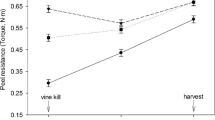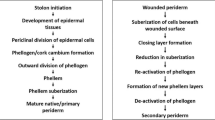Abstract
The susceptibility of potato tubers to excoriation (idiom = skinning injury) during harvest is a widespread problem that results in costly disease, defects, and shrinkage. Little is known about the physiology associated with susceptibility of immature periderm and the development of full and final resistance to skinning injury (skin-set) upon periderm maturation. The objective of this research was to determine the roles of phellem (skin) tensile and phellogen shear-related fractures in skinning injury and in the development of resistance to tuber-skinning injury upon skin-set. The resistance to skinning injury was measured on potato tubers with immature and mature periderm using genetically diverse cultivars during two growing seasons. Separate force measurements (mNm) were obtained to determine the relative strength associated with the “total resistance to skining” and the “phellogen shear component” (total resistance to skinning = phellem tensile component plus phellogen shear component). The relative strength of the “phellem tensile component” was calculated by subtracting the force measurement for the phellogen shear component from the total resistance to skinning. The results indicate that the phellem tensile component plays a minor role in the total resistance to skinning in immature and mature periderm. The relative strength of the phellem tensile component appeared to be nearly constant for all time points for each cultivar and did not measurably increase as the periderm approached maturation; this indicates that the phellem/skin tensile component does not contribute to skin-set development. However, the force required for fracture of the phellogen shear component did increase upon periderm maturation. These results indicate that the increased strength of the phellogen shear component was the determinant for the development of full resistance to skinning injury, i.e., skin-set. This research uncovers and defines the role of this second component, the phellem tensile component, for incorporation into the recently conceived paradigm for tuber excoriation and skin-set. These findings are consistent with and complement recent microscopical research which showed that the phellogen layer of immature periderm was the single tangential plane of fracture upon skinning and that this layer of cells was no longer prone to fracture upon development of full resistance to tuberskinning injury. The results were similar for all cultivars tested and provide a definite direction for future research on the biochemical changes and processes associated with phellogen cell wall strengthening, which comprises the phellogen shear strength component.
Similar content being viewed by others
Abbreviations
- Newton (N):
-
milliNewton meter (mNm)
Literature Cited
Baier, M.., R. Goldberg, A.M. Catesson, M. Liberman, N. Bouchemal, V. Michon, and C. Herve du Penhoat. 1994. Pectin changes in samples containing poplar cambium and inner bark in relation to the seasonal cycle. Planta 193: 446–454.
de Haan, P.H. 1987. Damage to potatoes.In: Rastovski, A., A. van Es et al. (eds), Storage of Potatoes: Post-harvest Behavior, Store Design, storage Practice, Handling. Pudoc, Wageningen, the Netherlands. pp. 371–380.
Hiller, L.K., D.C. Koller, and R.E. Thornton. 1985. Physiological disorders of potato tubers.In: Li, P.H. (ed), Potato Physiology. Academic Press Inc. New York. pp. 389–455.
Hiller, L.K, and R.E. Thornton. 1993. Management of physiological disorders.In: Rowe, R.C. (ed), Potato Health Management. APS Press, The American Phytopathological Society, St. Paul, MN. pp. 87–94.
Lulai, E.C., and D.L. Corsini. 1998. Differential deposition of suberin phenolic and aliphatic domains and their roles in resistance to infection during potato tuber (Solanum tuberosum L.) woundhealing. Physiol Mol Plant Pathol 53:209–222.
Lulai, E.C., and T.C. Freeman. 2001. The importance of phellogen cells and their structural characteristics in susceptibility and resistance to excoriation of potato tuber (Solanum tuberosum L.) upon periderm maturation. Annals Bot 88:555–561.
Lulai, E.C., and P.H. Orr. 1993. Determining the feasibility of measuring genotypic differences in skin-set. Am Potato J 70:599–609.
Lulai, E.C., and P.H. Orr. 1994. Techniques for detecting and measuring developmental and maturational changes in tuber native periderm. Am Potato J 71:489–505.
Lulai, E.C., and P.H. Orr. 1995. Porometric measurements indicate wound severity and tuber maturity affect the early stages of wound-healing. Am Potato J 72:225–241.
Lyshede, O.B. 1977. Studies on the periderm and epidermis of the potato tuberSolarium tuberosum L. cv. Bintje.In: Yearbook of the Royal Veterinary and Agricultural University, Copenhagen, Denmark, pp. 68–74.
Murphy, H.J. 1968. Potato vine killing. Am Potato J 45:472–477.
Niklas, K.J. 1992a The mechanical behavior of materials.In: Niklas, K.J. (ed), Plant Biomechanics. An Engineering Approach to Plant Form and Function. The University of Chicago Press, Chicago. pp.48–122.
Niklas, K.J. 1992b. Plant cell walls.In: Niklas, K.J. (ed), Plant Biomechanics. An Engineering Approach to Plant Form and Function. The University of Chicago Press, Chicago. pp.234–260.
Pavlista, A.D. 2001. Skin set evaluation by skin shear measurements. Am J Potato Res 79:301–307.
Peterson, R.L., W.G. Barker, and M.J. Howarth. 1985. Development and structure of tubers.In: Li, P.H. (ed), Potato Physiology. Academic Press Inc. New York. pp. 123–152.
Sabba, R.A., and E.C. Lulai. 2001. Histological analysis of the maturation of native and wound periderm in potato (Solarium tuberosum L.) tuber. Annals Bot 90:1–10.
Author information
Authors and Affiliations
Corresponding author
Rights and permissions
About this article
Cite this article
Lulai, E.C. The roles of phellem (skin) tensile-related fractures and phellogen shear-related fractures in susceptibility to tuber-skinning injury and skin-set development. Amer J of Potato Res 79, 241–248 (2002). https://doi.org/10.1007/BF02986356
Accepted:
Issue Date:
DOI: https://doi.org/10.1007/BF02986356




